- Camping Tips
- Hiking Tips
- RV Camping
- Destinations
- Blog
- Gear Reviews
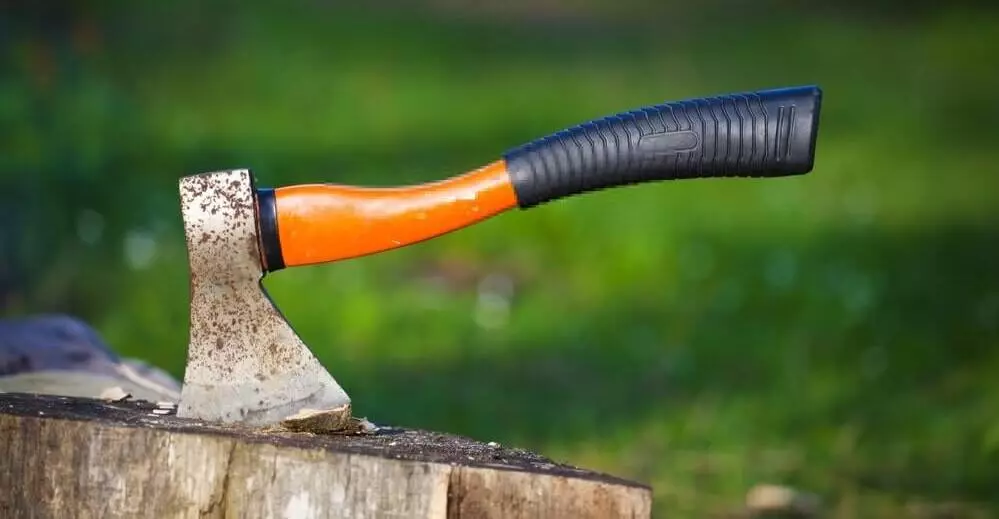
Our recommendations are based on thorough independent research, testing, analyses, and comparisons of different products. When you make purchases through links on our website, we may earn affiliate commissions.
Whether it’s the satisfying thwack of steel on wood or the immense power that comes with wielding it, a camping axe is one of the most indispensable outdoor tools. Camping axes and hatchets are, of course, wood chopping tools but can also be used to strike or as self-defense survival weapons.
Collecting firewood for that overnight campfire gets a lot easier if you have a good-quality axe or hatchet with you. And yes, even if all you need are chunks of deadwood, axes will help you trim them down to fire-sized pieces.
Like any other product, you will be bombarded with a gazillion of choices to pick from and what fun is that to have to go through such an exhausting ordeal?
Not to worry as we have scoured the very bowels of the camping axes’ market and found the very best just for you.
We will also arm you with the key factors to look out for when shopping for these essential wood chopping tools but first, here are our top ten picks of the best camping axes and hatchets.
| Axe/Hatchet Brand | Length | Weight | Sheath | Handle | Head Material |
|---|---|---|---|---|---|
| SOG Camp Axe | 11.5 in. | 1.01 lbs. | Glass-Reinforced Nylon | Glass-Reinforced Nylon | Steel |
| Schrade SCAXE2 Axe | 11.8 in. | 1.04 lbs. | Glass fiber | Glass fiber/PA & TPR rubber | Titanium-Coated Steel |
| M48 Tactical Tomahawk Axe | 15 in. | 0.43 lbs. | Nylon | Fiberglass-Reinforced Nylon | Steel |
| Gerber Bear Grylls Survival Hatchet | 9.46 in. | 1.3 lbs. | Nylon | Polypropylene | Carbon Steel |
| Husqvarna 26" Wooden Multi-Purpose Axe | 26 in. | 2.1 lbs. | Leather | Wood | Steel |
| Hults Bruk Akka Foresters Axe | 24 in. | 2.2 lbs. | Leather | Wood | Steel |
| Gransfors Bruks Small Forest Axe | 19 in. | 2.0 lbs. | Leather | Wood | Steel |
| Estwing Sportsman’s Axe | 14 in. | 1.7 lbs. | Nylon | Leather | Steel |
| CRKT Kangee Tomahawk | 13.75 in. | 1.53 lbs. | PVC/Acrylic Alloy (Boltaron) | Glass-Reinforced Nylon | Carbon Steel |
| Fiskars X11 Splitting Axe | 17 in. | 2.18 lbs. | Plastic | Fiber Composite | Steel |
The SOG camp Axe is a fun-size hatchet with a stainless-steel blade and glass-reinforced nylon handle. The hatchet measures 11.5 inches in length and is well-weighted for light tasks and even throwing.
A sheath made of the same durable material as the handle, together with its rubberized strap, is included to protect you and the blade.
The use of reinforced glass on the handle works seamlessly in absorbing any shock produced as you swing the axe. Additionally, the steel axe-head is tough and sharp enough to handle most light tasks such as chopping off foliage, driving in tent pegs and stakes as well as clearing trails and campsites.
The SOG hatchet is lightweight, compact and small in size making it a very portable tool to tag along your camping trip.
Its 3.1-inch blade, large enough for a clean and precise cut, delivers maximum cutting power.
The SOG Camp Axe doesn’t carry the heft or force hence it is best suited for chopping up prepped firewood into fire-size pieces. Notably, it can also be handy for steering in tent stakes and clearing off small branches. It will make do for a compact lightweight chopping tool that is easy to carry around for the typical weekender camping trip.
Specifically tailored for survival camping and lightweight works, the Schrade axe is an elegant and smaller-sized hatchet that’s worth checking out. Plus, who can pass up the extra perk of having a fire starter right there in the handle?
The Schrade’s camping axe outdoes itself at guaranteeing value for money — first with the budget-friendly pricing and second with the many benefits it packs. The 3Cr13 stainless steel axe head is titanium-coated to deliver unmatched strength and durability.
Additionally, the thermoplastic rubber handle offers a comfortable grip and ensures a balanced and firm contact when chopping or splitting wood.
The Ferro steel rod is tucked away in the handle and can be struck to start campfires whenever and wherever you pick. The included black sheath, on the other hand, allows for easy access and protection of the blade.
Although technically a hatchet, the Schrade SCAXE2 Axe will offer you the best bang for your buck if you are in the market for something versatile, lightweight and durable. The included fire starter is especially a very useful extra perk on this hatchet.
The M48 axe from United Cutlery is one of the most popular tomahawk axes in the market today. It is 15 inches in length from head to tail, which is a good size for light to medium tasks. The axe head is made of 2Cr13 steel and its cutting edge is pointy and sharp.
The head has three cutout holes to help reduce and distribute the overall weight for a balanced handling and less-tiring swing. The spiked edge can pierce through any material and would be very lethal against an aggressor.
To top it all off, the spike can be used interchangeably with the axe bit to pierce or split wooden planks and firewood into small sizes.
The glass fiber nylon handle is joined securely together with the axe head using rivets. A good portion of the axe head is also inserted in the handle for an even more secure and safe connection.
The grip on the handle is pleasant enough to hold and the slight bump in the middle allows for more control. You also get a lanyard hole at the base of the handle to help you holster and carry your tomahawk around with ease.
The steel variant used in the M48 is industry standard and offers average rust resistance as well as strength. And much as it becomes dull too quickly, it can be re-sharpened with ease unlike other grades of steel.
The design of the M48 follows a military theme; sharp spike, aggressive bevels, color scheme and so on. It is just as practical for combat as it is for lightweight woodwork and survival.
The M48 axe is a budget-friendly tomahawk that can be used for tactical needs as well as light wood splitting works. This is mainly due to the 1-inch thickness of its head at its core in addition to its compact design and tapered head.
A classical style axe on our list, this single-bit model from Husqvarna measures 26 inches in length. You get a beautifully-curved Hickory shaft with a steel axe head secured on one end and an eye on the base of the handle.
The long shaft will give you more oomph when swinging the axe making it ideal for several jobs like splitting large logs and felling trees. However, the lengthy profile is at the expense of portability thus you may find it a bit cumbersome to carry when backpacking or camping.
The cutting edge is razor-sharp right out of the box and sharpening it is just as easy. Additionally, its head is hand-forged and made of high-quality Swedish steel. Add this to the well thought-out wood grain orientation and what you get is a reliable axe with maximum impact resistance and durability.
Just as the company claims, you can use this axe for quite a lot; splitting wood, limbing logs, trimming branches, felling trees, and clearing trails.
However, the only drawback that just can’t be skimmed over is the leather wedges for covering the bit. The rivets on the wedges cause bumps on the axe bit making it pointless to use as a sheath.
Although an efficient, powerful and affordable axe, the Husqvarna axe may throw you off given its length and “interesting” blade cover. It’s heavy-duty and lightweight enough for bushcraft activities but the leather wedges shouldn’t be counted on.
The Bear Grylls survival hatchet from Gerber Gear is easily one of the most compact and slimmest yet functional chopping tools in the market today. It’s a backpackers’ and bushcrafters’ delight what with its lightweight profile and powerful blade.
This hatchet is a representation of Gerber Gear’s craftsmanship and Bear Grylls’ outdoors expertise so you can be assured of is sturdiness, solid build, and top-notch performance.
Weighing in at less than two pounds and having a length of only 9.46 inches, the hatchet doesn’t back down from any light-duty challenge. The 3.5-inch razor-sharp blade will have you limbing saplings and even splitting small logs.
The full-tang steel construction allows for durability and weight distribution for cleaner cuts through wood each time.
To get a hold on things, there’s an included rubberized grip at the base of the shaft that offers non-slip traction even when wet. Plus, there’s a hole at the butt where you can slip a lanyard through and attach the hatchet to your belt or backpack for extra safety. If you’re in the market for a backpacking hatchet, you’ve found your buddy!
Versatility is heavily factored in in this model as you can use the opposite of the blade for striking, driving-in stakes or even tenderizing meat.
Made of thick steel, this hatchet allows for powerful swings and optimal longevity. Its cutting edge will make bushcraft easy-peasy. The finger cutouts, just after the head, make it possible to choke up the hatchet and allow for more precision and control of your swings.
Lastly, the hatchet is powder-coated to prevent rusting and the blade is covered safely by the included reinforced-nylon sheath.
There’s not much to speak ill of the Gerber hatchet, but the manufacturer’s overreliance on the Bear Grylls’ brand may expose it to some harsh criticism. That said, the hatchet will come in handy for light tasks especially if you don’t camp too often.
The Gerber Bear Grylls Survival Hatchet is ergonomically-designed, powerful, compact, and lightweight making it perfect for general bushcraft activities.
The Hults Bruk brand is one of the most popular brands we have on the market right now. The Akka Foresters Axe is one of the most rugged and well-built traditional camping axes yet. It features a Hickory handle and well-fitted steel axe head that is covered by a leather sheath.
The overall design of the Akka camping axe is Swedish-inspired, ergonomic and true to the classic wooden style.
The sharpness of edge holds up quite well even with a week’s worth of whacking and log splitting while the axe’s balanced weight allows for more precise and powerful cutting. Notably, the axe is fairly compact, small-sized and easy to carry for minimalist campers and backpackers. But, as you will note, its excessive length is subject to scrutiny.
The hand-forged steel in the axe head allows for maximum longevity and a powerful cut with each swing while the tempered edges improve on the bit’s hardness and wood-penetrating power. The axe head weighs 1.5 pounds of the total 2.2 pounds making it perfect for lightweight woodwork and trail clearing jobs.
The orientation of the wood grain on the handle, in addition to the curved and lengthy style, allows for comfortable one-handed grip and more control.
The Hults Bruk brand carries on with its parent company’s rich history and reputation in making purposeful and stylish tools. The Akka camping axe is no different as it is sturdy, lightweight and very versatile, much to the delight of any forester or outdoors enthusiast.
Rocking a high-carbon steel head and a high-quality Hickory wooden handle is the Gransfors Bruks Small Forest Axe. This camping axe weighs only two pounds, 75 percent of which goes to the axe head alone.
Its 19 inch length is a bit on the extreme but still fairly an okay size for a portable chopping tool.
The Gransfors has a distinctively narrow axe head that you might assume will be its weak point or even get stuck when chopping logs. However, that’s not the case as the classic-looking blade is sturdy, durable and sharp enough to smite an orc into bits.
The wooden handles are applied after they have been dried so they don’t become loose when in use. This is evident in the final product as there are no gaps around the connection between the head and handle so you can split firewood without worrying about any dislodgement of the bit.
To protect and cover the blade, the axe comes with a strapped leather sheath made of vegetable-tanned leather. The strap wraps around the head to keep the blade in place so you don’t injure yourself when moving it.
The aptly-named Small Forest Axe is best for chopping or splitting softwood and managing other small tasks. If you care for the classic style and hand-forged steel axe head as well as its overall robustness, then this is definitely for you.
Keep in mind that the axe head, more so the blade, might get rusty when wet but some mineral oils and proper maintenance and care will easily take care of that.
The Estwing Sportsman’s Axe is made in Rockford, Illinois with the finest of materials and unmatched craftsmanship.
Right off the bat, the handle and overall design of the axe is one to be marveled upon; it’s complete with a comfortable lacquered leather grip and a one-piece steel construct. It is certainly the most gorgeous-looking chopping tool we have on our list.
Gone will be the stinging sensation on your hand when you strike something with an axe since the leather grip on this model will absorb all shocks on impact. It has the perfect size for backpacking and also comes with a leather sheath for safety and extra mobility.
Splitting small logs, trimming tree limbs, chopping small-sized wood, and tackling other light tasks when camping will be a cakewalk with this hatchet.
That said, the leather handle may not be as comfortable to hold over the prolonged use of the hatchet. So, you may want to use gloves to counter this and to further reduce the risks of blisters and pain.
Hand-polished and forged from high-quality steel, the Estwing hatchet is not only about impressive looks but also about excellent performance when it comes to accuracy, agility and cutting power. The hatchet is affordable, lightweight and best suited for very light tasks and sporting activities.
It suffers from a few letdowns but it is an overall good option to consider when shopping for a hatchet.
Also known as the Columbia River’s Kangee T-Hawk, this axe is essentially a tactical weapon designed by the gifted Ryan Johnson of RMJ Tactical. The Kangee T-Hawk has one-piece carbon steel construction with glass-reinforced nylon to offer the best mix of performance and value.
The long handle on this tool allows for great control, reach and powerful strikes while the tapered cutting edge delivers a very deadly blow. There’s a razor-sharp blade on one end and a deadly spike on the other end.
The Kangee Tomahawk is aggressive enough to be used by military and police teams and practical enough for your typical outdoor and camping use.
The blade is easy to sharpen and the grippy handle can always be removed for cleaning and general care and maintenance. Additionally, to protect you and the blade, the T-Hawk comes with a Boltaron sheath that buckles over the head.
Boltaron is one of the most impact-resistant PVC/Acrylic alloys in the market yet.
The sheath offers incredible abrasion resistance and will also fight off heat deformation and cold weather cracking without a sweat, keeping your bit protected for longer.
Included on the sheath is a shoulder strap and a Molle clip fastener for easy portability and attachment to a vest or belt. The shaft of this axe is contoured and contains finger grooves for improved handling, control and grip.
The Kangee Tomahawk is a professional tactical weapon that will do for survival needs, light tasks and even sporting activities. Although a bit pricey, the included high-quality materials, design, and functionality easily make up for that minor drawback.
Although available in a couple of different shaft lengths, we got to have a go with the 17-inch variant from Fiskars’ line of X-series axes. The X-11 is an affordable ergonomic wood splitter that blends the power of an axe and the mobility of a hatchet for truly practical performance.
Fiskars, a three-century-old Finnish company, specializes in making knives, scissors, gardening tools and a wide range of outdoor tools. Their handy craftsmanship and unique styling can be seen in all their products including the X-11 splitting axe.
Despite their mass-production approach, Fiskars still maintains the quality of most of their products at exemplary levels. The X-11 axe is made of hardened forged steel and lightweight but very sturdy handle.
Interestingly, the handle has a bright orange section at the end so it will be so much easier to spot it outdoors, plus it’s very stylish.
The bevel convex geometry of the head and its overall weight distribution ensures you get a powerful swing each time. Additionally, the low-friction coating allows it to cut through wood without the bit getting stuck.
At the base of the handle, the axe provides a textured non-slip grip plus a curved section for extra control and handling.
Its weight is well distributed allowing for a heavier head over the lightweight fiberglass handle for excellent backswings, speed, and impactful strikes. The X-11 will do it all around the campsite; from splitting small to medium logs, felling small trees to even clearing trails.
The X-11 handle is made of the company’s proprietary FiberComp, which is a strong durable fiberglass composite that absorbs any shock generated when splitting wood. It’s also very lightweight so your arms won’t tire too easily.
The connection between the head and handle is pretty solid so you don’t have to worry about the head flying off even with the most powerful of strikes.
The X-11 is comfortable and effective for one-handed operation as well as with both hands and is best suited for quick campsite jobs. It’s a little larger and heftier than a typical hatchet but this counts on its considerable striking power and cutting accuracy.
Additionally, you will be covered for any defects on the product with Fiskars lifetime warranty and there are about four other size variations you can pick from.
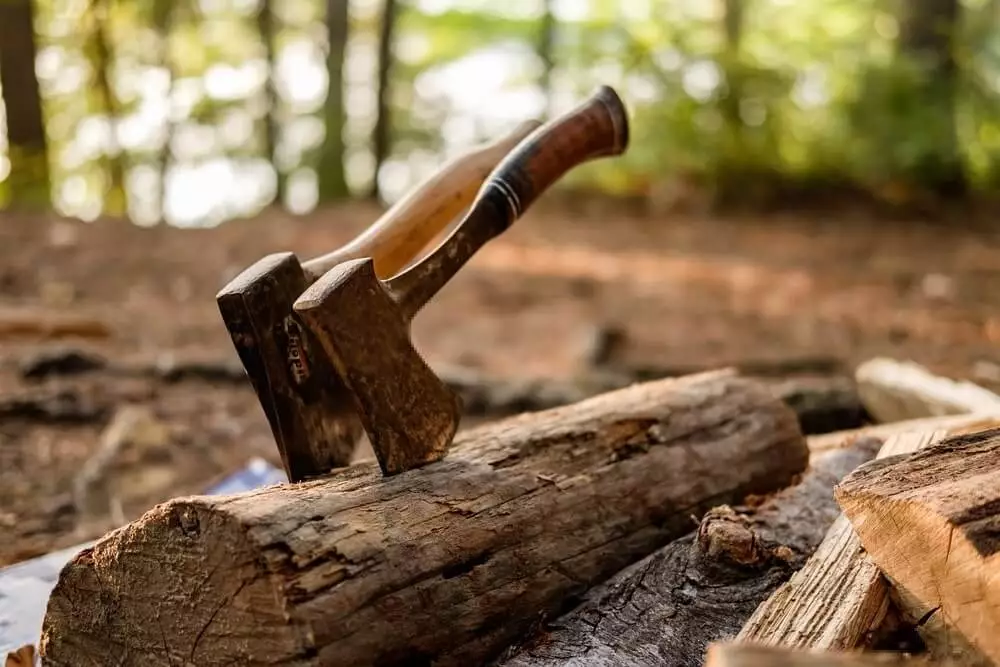
Put plainly, an axe is just a blade that is attached to a long handle for uses such as felling trees, splitting firewood, and hewing lumber. An axe requires a two-hand operation due to its weight and size.
Typically, more weight and length mean more cutting power and few backswings on axes. However, they are not as portable as hatchets. Broadaxe, carpenter’s axe, mortising axe, and an adze, are just a few of the various types of axes you can find in the market today.
The uses for any type of axe will mostly be determined by the width, angle, and sharpness of its bit.
A hatchet, on the other hand, is a small one-hand axe that is mostly used for chopping small tree branches or splitting firewood. It’s small, lighter and may have a hammer head that can be used for striking purposes.
When it comes to a camping axe/hatchet, you will most probably be looking at portability and that leaves you with two choices; a hand axe and a hatchet.
Hand axes or camping axes are smack dab in the center of hatchets and axes. They can be operated with one hand despite sporting longer handle shafts than hatchets. However, camping axes are not as lightweight, portable or small as hatchets are.
Camping axes perform the usual; splitting wood into tinder, chopping firewood and rarely for striking purposes.
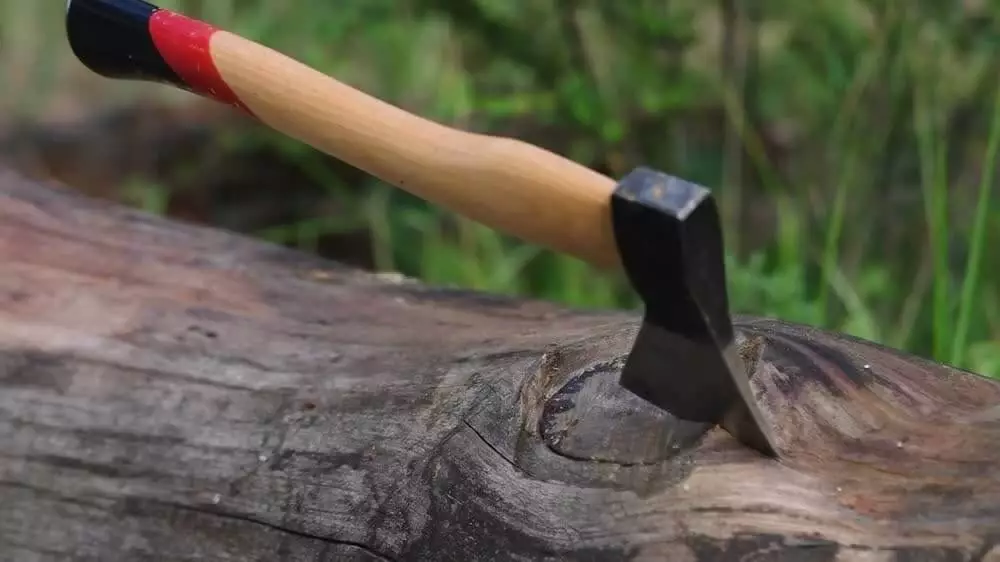
A key place to begin is to identify what exactly you need an axe or hatchet for, which would usually fall under two categories; campsite activities and self-defense.
Backpackers, hikers, backcountry campers and other light campers will most likely prefer a hatchet for its versatility. RV and car campers may choose either as they will not be bottlenecked by weight restrictions.
In both scenarios, you will still be able to chop firewood, shave off tinder, split small logs, and drive in tent stakes with the only compromise being on the wood-processing capacity.
Most hatchets will do the job when it comes to self-defense, especially those with a long shaft. A hatchet that will keep some distance between you and your aggressor and offer more accuracy is the tomahawk, which is specifically designed to be used as a weapon.

These two factors mainly influence the portability and cutting capacity of the axe or hatchet.
Large, longer models tend to snag on thick foliage or undergrowth when bushwhacking, weigh more and can be tiring over repeated minor tasks. However, they are more impactful when performing heavier tasks like splitting logs and chopping wood.
In comparison, shorter and smaller form factors provide unmatched dexterity, accuracy, and speed when carrying out light campsite tasks.
In theory, the longer the axe/hatchet, the more force you will impact on the wood but at the expense of accuracy and control.
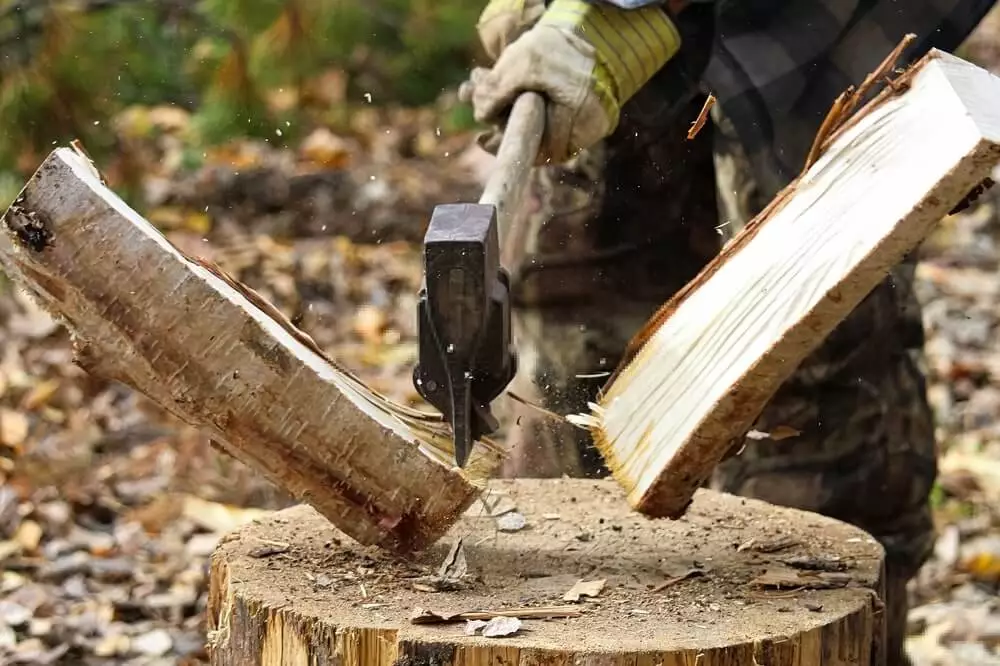
In a nutshell, if the bulk of the weight of the axe/hatchet is mainly in the head then you get more control and greater power when chopping.
The overall weight of the camping axe or hatchet will also greatly influence portability, so be keen on that too. A camping axe/hatchet that weighs way below five pounds will be more than adequate for your camping needs.
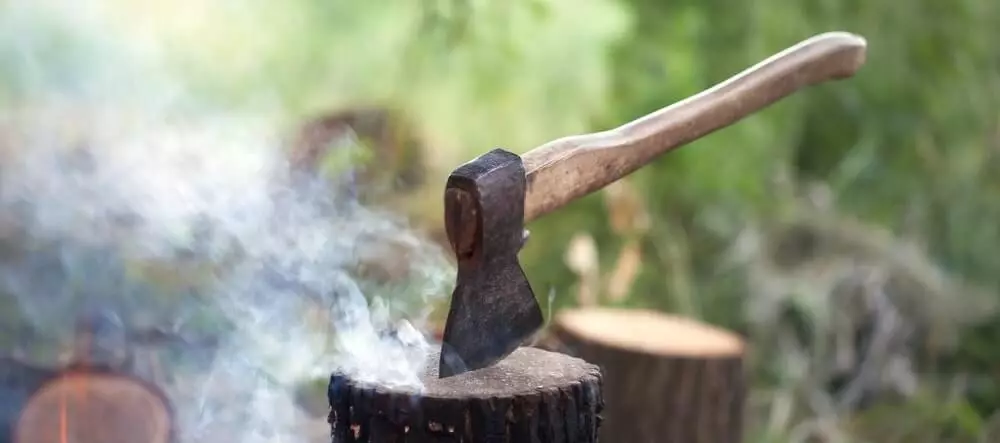
The handles for these tools may come in a straight or curved style. A curved handle will feel more natural in your hands. However, you only get the straight handle option on the double-bitted head for obvious reasons.
When it comes to the handle material, you get options such as traditional wooden style, plastic, fiberglass, nylon, rubber, and leather.
Hickory wood and ash are the best choices to go for if you are for the old-timey wooden handle.
The wood grain on the handle ought to run longitudinally rather than transversely. Plus, the growth rings must be numerous and narrowly spaced. These two factors will impact on the durability of the handle and its ability to withstand extreme force.
Hickory wood is preferred by most manufacturers for making up the handles due to a couple of reasons. The dry wood has beautiful contrasting bands of color that give off an antique look, plus it’s durable, strong and shock-resistant but flexible with a straight and coarse grain.
Aside from the single-piece steel units, wooden handles can be easily and cheaply replaced. Notably, wooden handles don’t offer a good grip when wet, especially the varnished kind.
Textured plastic or nylon handles may not be as grippy or comfortable to use as other options. Fiberglass suffers from the same drawback and is too light thus requiring more swings for an impactful performance.
Leather and rubber offer the highest levels of grip and comfort without risks of the axe slipping or you getting blisters and sores. The biggest drawback for the two is that they wear off rather quickly as compared to the other options.
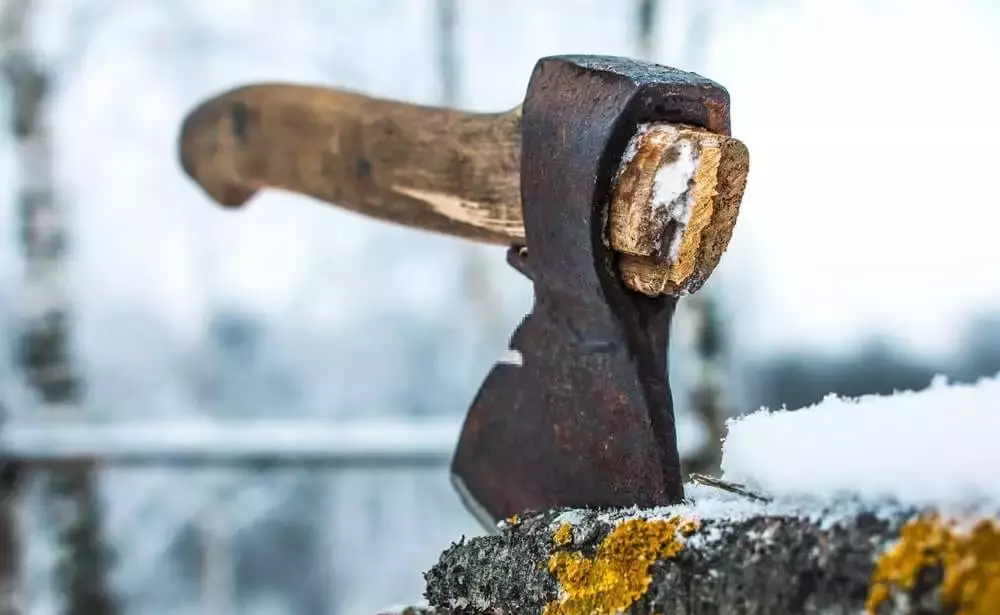
Use of steel is fairly industry standard when making the axe/hatchet head, so you can expect nothing less. The only thing to ponder about when it comes to the bit is the way it was made; hand-forged or machine-forged.
Hand-forged steel, particularly from Sweden, the land of Vikings, is done through a laborious process which is reflected in the high prices for such axes/hatchets. There’s no consensus on the superiority or inferiority of either so you will have to go with our gut feeling on this one.
For the best cutting efficiency, go for an axe/hatchet with a bit that is not too narrow or too wide. If the bit is too narrow, it might get stuck when chopping large logs and if it’s too wide then it gets a little bit complicated when trimming branches.
Keep in mind that high-carbon steel axe heads offer the best performance and durability. Even then, low-quality options may chip or soften around the cutting edge.
Lastly, a double-bit axe provides a more balanced swing and versatility while a single-bit axe excels at speed and cutting power. If throwing axes/hatchets in the outdoors for sport, then a double-bitted head will be your choice due to its balanced weight.
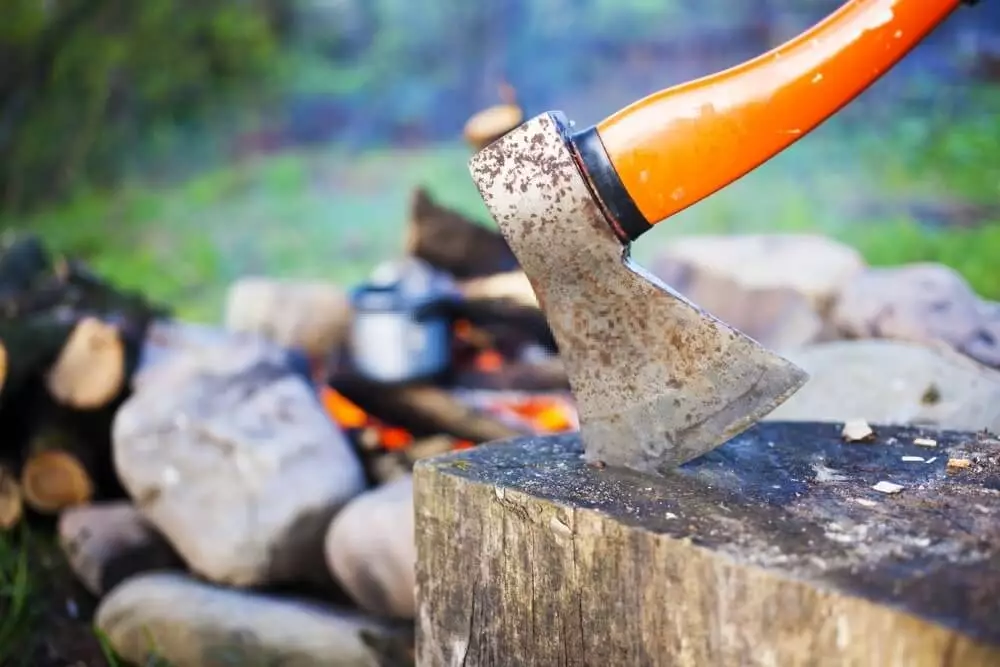
The build and more so the materials used on the axe or hatchet should be of high quality or else you will be shopping for the same tool every few months.
You can never go wrong with stainless steel and a sturdy shaft with adequate length and sticky grip. Such a combo will offer optimal longevity and a good balance of weight between the shaft and head.
Also noteworthy is that even though wooden handles are grippy and aesthetically appealing, they may be susceptible to splintering, rot and even contorting over time. Therefore, for a more durable option, always consider steel, fiberglass, reinforced nylon and other composite materials for the handles.
Arguably, one-piece full-tang hatchets and camping axes offer the best durability as they eliminate the risk of loosening that is present in other models where the shaft joins with the head.
As a safety precaution, if you intend to move around with a camping axe or hatchet, then a cover or sheath for the blade will be needed.
Most manufacturers will use leather for the sheaths due to its stylish look and rugged functionality while others may use nylon or other composite options. The nylon used in the sheaths is very tough and thick and will be just as effective in covering the sharp cutting edges of the axe or hatchet.
A good option if you are keen on portability and value for money is to go for a sheath with a handle.
Unless you are in the market for an antique camping axe or hatchet that can only be found in very exclusive markets, then a good tie-breaker would be to go for the top-rated and trustworthy brands.
Gransfors Bruk, CRKT, Estwing, Gerber, Klecker Knives, Ontario Knife Company, Outdoor Edge, and Wetterlings are trustworthy brands to look out for. Just don’t forget the magic attributes; durability, cutting power, accuracy, utility, size, and agility.
Whether you’re carrying out campsite preparation, driving in tent stakes, creating a campfire or hitting a backcountry trail, a good quality hatchet or camping axe will be of great use. We hope that the above information will be helpful to you when shopping for either of these camping essentials.
All said and done, the head of the axe or hatchet is the most important bit, pun intended, of the whole apparatus. So, keep it sheathed and sharpened delicately when not in use.
Charlie Leone
Website Owner/Editor
Welcome to CampingManiacs